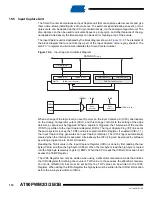
108
4317I–AVR–01/08
AT90PWM2/3/2B/3B
The following code examples show how to do an atomic write of the TCNTn Register contents.
Writing any of the OCRnx or ICRn Registers can be done by using the same principle.
Note:
1. The example code assumes that the part specific header file is included.
For I/O Registers located in extended I/O map, “IN”, “OUT”, “SBIS”, “SBIC”, “CBI”, and “SBI”
instructions must be replaced with instructions that allow access to extended I/O. Typically
“LDS” and “STS” combined with “SBRS”, “SBRC”, “SBR”, and “CBR”.
The assembly code example requires that the r17:r16 register pair contains the value to be writ-
ten to TCNTn.
15.2.1
Reusing the Temporary High Byte Register
If writing to more than one 16-bit register where the high byte is the same for all registers written,
then the high byte only needs to be written once. However, note that the same rule of atomic
operation described previously also applies in this case.
15.3
Timer/Counter Clock Sources
The Timer/Counter can be clocked by an internal or an external clock source. The clock source
is selected by the Clock Select logic which is controlled by the Clock Select (CSn2:0) bits
located in the Timer/Counter control Register B (TCCRnB). For details on clock sources and
prescaler, see
“Timer/Counter0 and Timer/Counter1 Prescalers” on page 83
Assembly Code Example
TIM16_WriteTCNT
n
:
;
Save global interrupt flag
in
r18,SREG
;
Disable interrupts
cli
;
Set TCNT
n
to
r17:r16
out
TCNT
n
H,r17
out
TCNT
n
L,r16
;
Restore global interrupt flag
out
SREG,r18
ret
C Code Example
void
TIM16_WriteTCNT
n
(
unsigned int i
)
{
unsigned char
sreg;
unsigned int
i;
/*
Save global interrupt flag
*/
sreg = SREG;
/*
Disable interrupts
*/
_CLI();
/*
Set TCNT
n
to i
*/
TCNT
n
= i;
/*
Restore global interrupt flag
*/
SREG = sreg;
}
















































